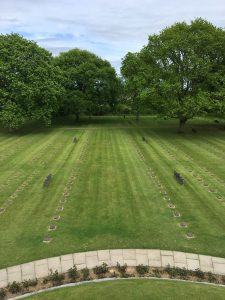Our arrival in Bayeux, France introduced many of us to a truly different culture. Where Londoners shared our love of the English language, most the people in Bayeux have a much smaller desire to speak and learn English. It really hit me that we were in unfamiliar territory. Yet, American and British flags line the streets. Entrepreneurs named their restaurants “Overlord Café” and “Omaha beach restaurant.” The marriage of Americanized establishments with ethnically and culturally different people gave me a truly shocking experience.
Unfamiliar territory was the theme of most World War II French museums. The Caen museum was our first encounter with the French version of WWII. While the museum itself is Americanesque (history is truly written by the victors), it has a strong French flair. As an American, we rarely come across histories of our nation from a universal narrative. Yet, this is exactly how most WWII French museums are designed. Every gallery focused on what brought Hitler to power. They point to Nationalism and failure of international powers to answer, including France and Britain. From here, the Caen museum focused on the scope of WWII. They narrated the North African campaign, the Eastern front, and then emphasized Operation Overlord, the invasion of Nazi occupied France.
Operation Overlord earns an entire exhibit wing. This was both surprising and unsurprising. It was unsurprising because the French Resistance played a crucial role in intelligence and disruption of German movement. Operation Overlord also brought the eventual end to Nazi occupation of France. Yet, I was surprised because the invasion fits unevenly into the French memory of the war. Americans love to believe every Frenchmen viewed them as liberators and saviors. Yet many French, particularly Normans, paid a high price for liberation. Allied pre-D-Day bombing decimated cities. Many faced the duality of liberation without a home. The Overlord museum covers the contentious nature of the bombings, but lightly. Anyone unaware of the French narrative would not notice the passive-aggressive language.
However, the most moving sites were not museums, but cemeteries. The German cemetery really moved me. Most of the men buried in Normandy were either younger than 20 or over 30. In fact, out of 30 randomly chosen graves, I found an average age of 32. Hitler, afraid of the Soviet steamroller, reinforced his Atlantic army with the old, the young, and the maimed. Many German defenders were Poles, Ukrainians, Czechs, or Soviet prisoners of war. They supplemented hardy veterans who transferred to France for recuperation. Despite this diverse fighting force, the German cemetery was homogenous. Every grave had the same tombstone, and every grave listed the same information. Not one listed nationality. Not one listed religion.
As an American and Marine, the American cemetery touched a nerve. At any angle, the graves are perfectly covered and aligned. The plots are the neatly assembled formations for the deceased, who await their final dismissal for Valhalla, heaven for combat heroes. These men were the true heroes of WWII, paying the ultimate price for a group of humans most had never met. A teary eyed salute to the fallen ended an emotional day abroad.
The most moving site was Omaha beach. My imagination immediately kicked in, and I saw young men as they approached the unknown. At low tide, these men crossed a gauntlet of obstacles and open terrain some 500-700 yards long. They were cold, tired, sick, and afraid. Hidden German machine guns took pot shots at the slow-moving landing crafts The Germans used the landing craft’s large steel ramps as practice for the Americans behind them. As the ramps dropped, many Americans were cut down before spotting their assailant. Several boats were annihilated before hitting sand. Those who disembarked successfully faced a wall of German fire crisscrossing the beach. These men were drenched, weighing around 60-100 pounds more with soaked gear. 29th Division’s Company A is a grim reminder of the sacrifices at Omaha. By the evening of June 6th, only 18 of 230 Company A men remained unharmed.
For the American narrative, the Bayeux area is filled with historical artifacts and grim reminders of the sadistic and gruesome nature of war. For many of us, Bayeux became the first personal taste of WWII. The French theme of universalism helps give a scope of the massive scale of WWII, and has opened up my eyes for the remained of this trip.



